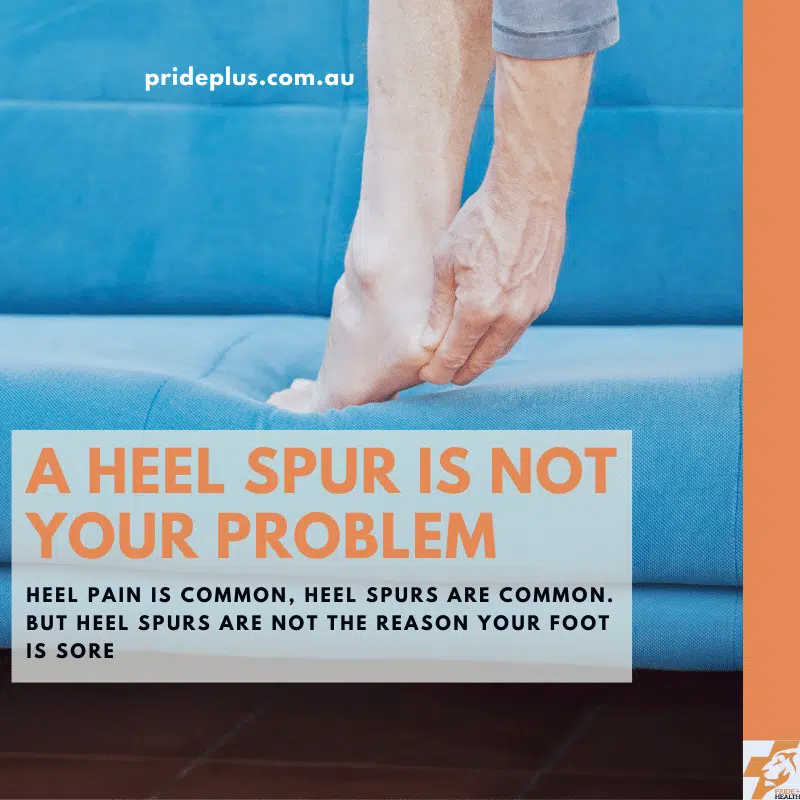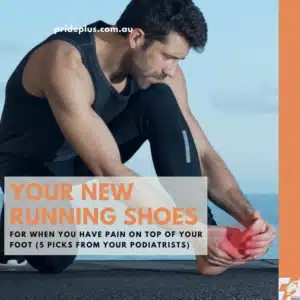A heel spur is not the reason you have heel pain.
But wait. Tim, you’re telling me that the heel spur I can see on my X-ray from my doctor that is in the exact position of my heel pain is not the problem?
Yep. How about these statistics for you:
- 11% of people have heel spurs.
- 5% of people who have heel spurs have heel pain.
- 48% of people in Australia suffer with heel pain at least once per week.
So, we know that plenty of people have heel spurs, but only a few suffer with heel pain AND a heel spur. Many more suffer with heel pain WITHOUT heel spurs.
How this myth of the heel spur started was likely the early prevalence of X-ray imaging. When we first started shining radiation through the body at sore spots we found lots of interesting things, including the relatively common heel spur. For a while, we thought that was the problem with morning heel pain.
But time marches on.
These days with better imaging in the form of MRI (magnetic resonance imaging) and Ultrasound imaging we can see just what is going on in your heel. And it’s not a heel spur.
A heel spur is normal and rarely needs treatment
How are 95% of people with heel spurs walking around without heel pain?
Because heel spurs are a normal anatomical variant. Your body does a mighty fine job of keeping you moving and a heel spur is usually just a version of building resilience. If you strain the attachments to your heel bone consistently over time you will build up stronger osseus (bony) connections which on X-ray will look like heel spurs.
If you’ve just been for a quick trip to a doctor for your heel pain and been sent for an X-ray, there’s an 11% chance that those X-rays will show up heel spurs. X-rays are fantastic at showing the shape of your bones but they don’t show pain or changes to other tissues.
If you dig a little deeper you’ll usually find one of 6 different types of tissue overload leading to heel pain:
- Plantar fasciitis
- Baxter’s nerve entrapment
- Fat pad odema / fat pad herniation
- Achilles tendonitis
- Calcaneal stress fracture
- Retrocalcaneal bursitis
You can find out which one is most likely causing your heel pain by taking the free online heel pain test.
These 6 injuries are unlikely to show on X-ray imaging so your going to be stuck. Your heel is sore. Your X-rays show that everything is normal but maybe you have a heel spur. Ta-da, your heel pain must be from a heel spur.
Still with me? Now let’s discover together what you should do instead.
Treat the causes of and your type of heel pain
Get into your podiatrist with your sore heel and find out what and why you have heel pain.
A clinical examination, appropriately referred imaging (ultrasound or MRI) and a thorough history will have you set to start achieving your goals. You can start by thinking of it as these three steps
What is sore?
Work with your podiatrist to determine what around your heel is sore. By now you know it’s not going to be a heel spur.
Why is it sore?
These are the factors that are leading to your heel pain. For some of us it’s our foot function. The shape and way it moves. For others, it’s our capacity. Too many things taking away our resilience to handle the extra life throws at us.
Together your podiatrist and you will work this one out pretty quickly.
What are you going to do about it?
Now the magic happens. What changes do you need to make with your podiatrist guiding you along the way?
- Exercises to build resilience and capacity?
- Shoes, tape or orthotics to de-load and de-stress your heel?
- Medications or other treatments?
So don’t fall into the trap of lazy health care. The version of oh, heel is sore, there’s heel spur, it must be the heel spur leading to your heel pain.
You don’t have the time, money or patience to muck around with things that aren’t helping or evidence based. There’s a better way.
Start with your free online heel pain test and book in with your PridePlus Health podiatrist today.
About the Author

Podiatrist Tim Mulholland has spent years helping those in Pascoe Vale and Melbourne overcome foot pain. He’s particularly passionate about the role podiatrists have in educating and debunking old myths in health care.
He’s part of the podiatry, physiotherapy and exercise physiology team at PridePlus Health who developed an online heel pain test to help those all over the world better understand what is causing the pain under their heels.
Our Best Heel Pain Content
If you’re made it this far and have organised your heel pain test and podiatry session, stick around for more great content on heel pain.




